| THE MUSTANG | 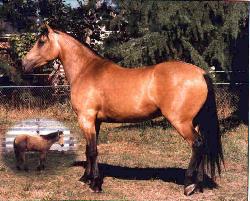 "High Desert Brumby", an Oregon Mustang from the Warm Springs HMA. Adopted at 11 months (see insert) Brumby is now 16 hands and 1300 lbs. Courtesy of Karen Goodroad |
Mustangs are found in all colors and combinations, all sizes and builds. Most common are browns, bays, chestnuts, duns; 14-16 hands; slight in build. One very impressive working Bureau of Land Management Mustang was 18 hands. Mustangs are very tough, strong, agile, sound, quick to learn, and when you gain their loyalty, they follow directions easily.
HISTORY
In 1492, Columbus sailed the ocean blue and in the holds of his ships were horses. Sleek, desert-bred, hardy little horses. Over time, the explorers and their horses spread throughout the west. Wherever these newcomers settled, the missions, with their large herds of livestock, followed. The horse was highly prized by the Native Americans who liberated him from the Spanish.
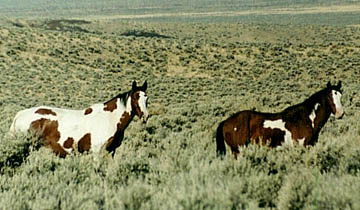
The Native Americans' philosophy was not one of containment, and the missionairies had no real interest in livestock accounting, so thousands of horses were allowed to wander off. These free horses prospered and were the founding stock of today's Mustang.
| By the beginning of the 19th century, the railroad had spread across the west, bringing death and destruction to all in it's path. The white settlers systematically reduced the bison herds from 60 million to several hundred animals; they massacred the Indians and contained what was left of the tribes; then they turned their contempt and their guns on the Mustangs. As a break from the tedium of cross-country travel, the Transcontinental Railway encouraged its passengers to shoot bison and wild horses within range of their trains. | 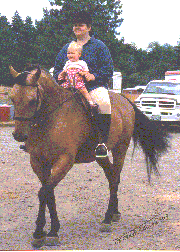 "High Desert Brumby", an Oregon Mustang from the Warm Springs HMA Courtesy of Karen Goodroad |
From the journals of the missionairies came these reports: In 1807, two herds of 7,000 wild horses each were driven into the ocean at Mission Santa Barbara to drown; and, at the San Diego Mission, wild horses by the hundreds were shut in corrals to starve.
During the "great drought of California" between 1828 and 1830, ranchers killed about 40,000 horses who were eating the pastures the ranchers wanted for their cattle and sheep. Though the herds were severely decimated throughout the west, the Mustangs were considered a nuisance by the ranchers, who wanted the open range for cattle which were revenue-producing, and by hunters who wanted to import bighorn sheep to kill. Mustangs fell prey to the same single-mindedness which poisoned the grizzly and shot out the native elk.
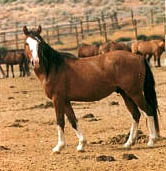
Ranchers, hunters and missionaries weren't the only groups profiting from the death of wild horses. Processing of horses reached a peak in 1933 when 29,610,381 pounds of horse meat were canned. In the 1920's, chicken feed processing plants were paying $5.00 per horse. This practice continued until 1970. In 1924, the pet food industry edged into the horse killing market, killing approximately 500 horses per day. In 1928, 40,000 horses were killed for pet food.
Protected from being killed or harassed while on Federal BLM lands since the the 1971 federal "Wild Horse and Burro Act", wild horses are still subject today to death or displacement by fire, drought, humans with guns illegally shooting them on federal lands, overgrazing, straying off federal lands onto non-protected areas and being "disposed of" sometimes by other, non-BLM federal agencies, and lost legal battles with cattle grazers for rights to federal land. Currently there are less than 50,000 Mustangs remaining--with many herds numbering below the population numbers needed to stay healthy and free from inbreeding. Experts agree that at the present rate of decline, the Mustang could become extinct by the end of the century.
Determined efforts are now being made to preserve the remaining wild horses by the BLM, and organizations such as Wild Horse Research LEFT at Porterville, CA, the International Society for the Protection of Mustangs and Burros in Scottsdale, AZ, and the North American Wild Horse and Range Systems. Important strains of Mustang are being recognized and preserved, such as the Cayuse Indian Pony, Chickasaw Indian Pony (also known as Florida Cracker Horse), Spanish Barb, the Rocky Mountain Pony, and the Kiger Mustang.
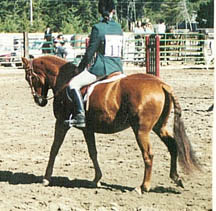
Visitors to the many areas of the U.S. can still see colorful herds of wild horses running free--not only just in the Western states. Mustangs roam in eastern and central states as well, and BLM holding facilities and sanctuaries also provide the opportunity for the public to observe wild horses in large numbers.
| For more information on how to view wild horses, their history, behavior, adoption and handling, a book entitled "The American Mustang Guidebook" (by Lisa Dines, Willow Creek Press) will become available in Spring of 2001. The more people who care about and value these unique wild horses, the more protected they will be! |  |
This article was kindly provided by Michelle Staples, Staples Stables, and Lisa Dines, of ForestHorse
Please click here to visit the Bureau of Land Management National Wild Horse and Burro Program website